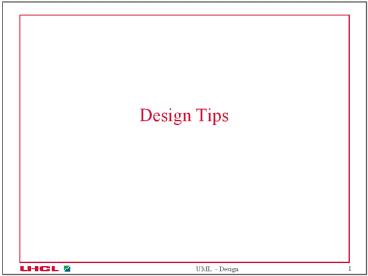Design Tips PowerPoint PPT Presentation
1 / 11
Title: Design Tips
1
Design Tips
2
Becoming Good OO Developers
- Developing good OO Software is hard
- Takes a lot of time to take advantage of all OO
features - Lots of Experience needed to become good
designers - Many systems are not leveraging OO advantages
- To master OO software design, study experienced
developers design - Reuse proven software design
- gt Patterns can help
3
Design Tips Hints (High level Patterns)
- Layering
- Improves stability, understandability,
flexibility - Reduces impact to changes
- Restrict dependencies/coupling between
packages/subsystems - GUI (Boundary Classes) separated in one
layer/package - Allow the User Interface to change without
impacting the rest of the system - Package Functionally related Classes
- Changes in one Class impact the other Class
- Rich Interaction between Classes
- Package should be cohesive
- Reuse proven software design
- gt Patterns can help
4
Design
5
Design
- Refine the Class Diagram
- Structure system
- Subsystems, Interfaces, Classes
- Define subsystems dependencies
- Capture major interfaces between subsystems
- Assign responsibilities to new design classes
- Describe realization of Use Cases
- Use Sequence and Collaboration Diagrams
- Assign visibility to class attributes
- Define Methods signature
- Develop State diagram for relevant design classes
- Use Interaction Diagram to distribute behavior
among classes - Use Design Patterns for parts of the system
6
Design Problems
- Rigidity Every change causes a cascade of
subsequent changes in dependent modules - Fragility Tendency to break in many places every
time the software is changed - Immobility Inability to reuse software from
other projects or parts of same projects - Viscosity Easier to change the software by
breaking the architecture rules than by
respecting them.
7
Design Principles
- Open-Closed Concept
- Software Entities (Classes, Modules, Functions)
should be Open for Extension, but Closed for
Modification - (Change the what modules do without modifying
their code) - Design by Contract
- Use Assertion, Pre-condition, Post-condition, to
ensure robustness and corrrectness. - Assertion property of some of the values of the
program entities. - Pre-condition expresses the properties that must
hold whenever the method is called - Post-condition expresses the properties that the
method guarantees when it is called
8
Design Principles (cont.)
- Dependency Inversion
- Primary mechanism / strategy
- Depend upon interfaces or abstract classes rather
than upon concrete methods and classes. - Interface segregation
- When a class has multiple clients, create
specific interfaces for each client. - Packaging principles
- Common Closure Classes that change together,
belong together. - Dependencies between packages should not form
cycles - Depend in the direction of stability
9
Other Processes
- OPEN
- Object-oriented Process, Environment, and
Notation - Third-generation, public domain, full lifecycle,
process-focused, methodological approach - Work Products components that are developed by
the project. - Languages components used to document most work
products. - Producers components that develop work products.
- Work Units components that model the operations
performed by producers when developing work
products. - Stages time intervals that provide a macro
organization to the work units.
10
Other Processes (cont.)
- Extreme Programming
11
UML Use
- OPEN
- Web Applications
- J2EE Architecture
- XML applications

